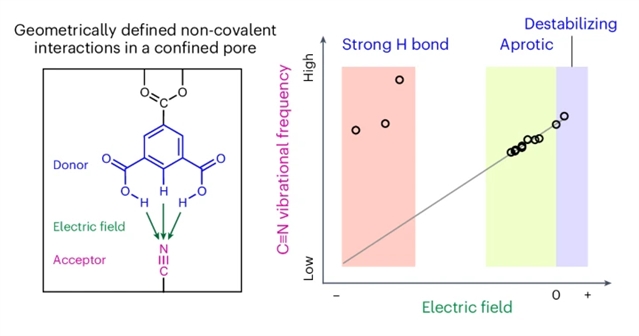
近日,北京大学季者团队实现了非共价相互作用的静电图谱内置于金属有机框架。相关论文发表在2025年8月27日出版的《自然-化学》杂志上。
非共价相互作用是物质组织和分子识别过程的核心,但它们很难表征。
研究组设计了一个平台策略,通过将金属有机框架(MOFs)作为分子支架,系统地将与选择性化学基团的非共价相互作用构建成精确设计的构型。利用振动Stark效应对计算机模型进行基准测试,研究组发现电场为量化MOFs和溶剂化环境中不同的非共价相互作用提供了一个统一的度量。
研究组在金属有机框架(MOF)结构内利用腈基探针合成并光谱分析了系列非共价相互作用,鉴定出通过多重氢键叠加产生的高达-123兆伏/厘米的稳定场、反平行偶极间罕见的+6兆伏/厘米去稳定场、高达34cm-1的反常氢键蓝移现象,以及纳米限域环境下独特的溶剂化效应。这种制造和测试非共价相互作用的方法为探索非共价相互作用开辟了新的途径。
附:英文原文
Title: Electrostatic atlas of non-covalent interactions built into metal–organic frameworks
Author: Ji, Zhe, Mukherjee, Srijit, Andreo, Jacopo, Sinelshchikova, Anna, Peccati, Francesca, Jimnez-Oss, Gonzalo, Wuttke, Stefan, Boxer, Steven G.
Issue&Volume: 2025-08-27
Abstract: Non-covalent interactions are central to the organization of matter and molecular recognition processes, yet they are difficult to characterize. Here we devise a platform strategy to systematically build non-covalent interactions with selective chemical groups into precisely designed configurations by using metal–organic frameworks (MOFs) as the molecular scaffold. Using the vibrational Stark effect benchmarked against computer models, we find the electric field provides a unifying metric for quantifying diverse non-covalent interactions in MOFs and solvation environments. We synthesize and analyse spectroscopically a collection of non-covalent interactions using a nitrile probe within the MOF structure, and identify stabilizing fields as strong as 123MVcm1 produced additively by multiple hydrogen bonds, an unusual destabilizing field of +6MVcm1 between antiparallel dipoles, anomalous hydrogen-bond blueshifts as large as 34cm1 and unique solvation under nanoconfinement. This method for making and testing non-covalent interactions opens new avenues for exploring non-covalent interactions.
DOI: 10.1038/s41557-025-01916-7
Source: https://www.nature.com/articles/s41557-025-01916-7
Nature Chemistry:《自然—化学》,创刊于2009年。隶属于施普林格·自然出版集团,最新IF:24.274
官方网址:https://www.nature.com/nchem/
投稿链接:https://mts-nchem.nature.com/cgi-bin/main.plex
